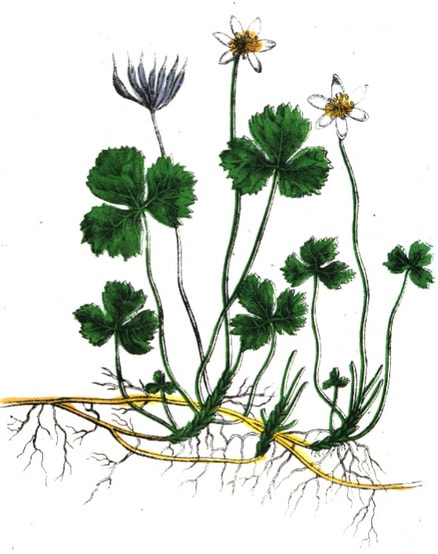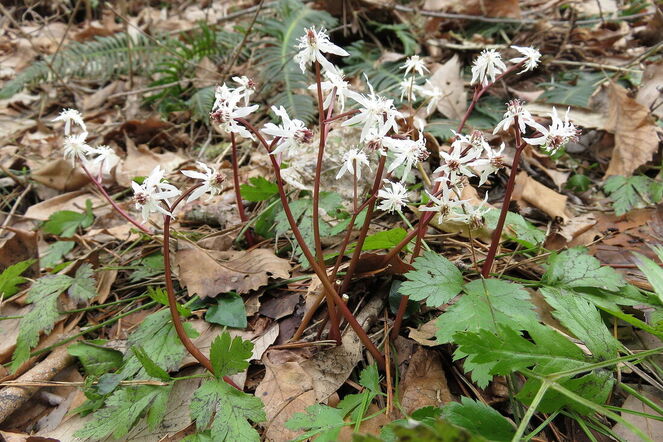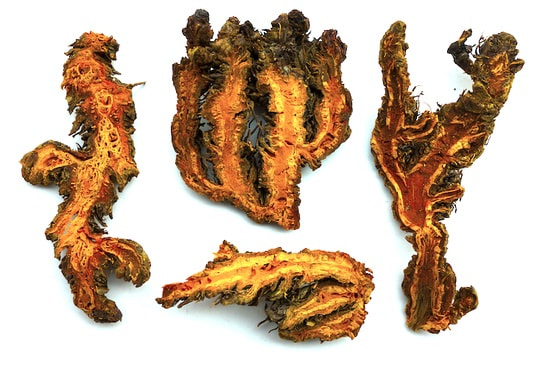Coptis trifolia
Materia Medica Botanica, Wellman, 1845
Materia Medica Botanica, Wellman, 1845
Slices of Coptis Huang Lian showing bright yellow-orange cross-section (Adam, 2017)
Botanical name:
Coptis spp.:
Several species are used:
The American C. trifolia (Gold Thread) can probably be considered synonymous.
Parts used:
Rhizome
Temperature & Taste:
Cold, dry. Bitter
Classification:
B. Clear Heat & Damp
Coptis spp.:
Several species are used:
- C. chinensis (TCM, Tibet)
- C. deltoidea (TCM)
- C. teeta (syn. C. teetoides) (Tibet, Unani, Ayurveda, TCM)
The American C. trifolia (Gold Thread) can probably be considered synonymous.
Parts used:
Rhizome
Temperature & Taste:
Cold, dry. Bitter
Classification:
B. Clear Heat & Damp
ADVERTISEMENT:
Uses:
1. Clears Heat and Damp:
-heat-type Diarrhea or Dysentery (TCM, Ayurveda, Tibet)
-Nausea, Vomiting, Acid Reflux from Stomach heat
-"Its root is useful in Jaundice" (Avicenna)
-'good for dispersing pathogenic Cold and Heat in the Five Viscera'. (Ming Yi Bie Lu)
2. Clears Heat and Fire, Resists Toxin:
-High Fever, Irritability, Delirium, with a red tongue and a full and rapid pulse (TCM, Ayurveda, Tibet)
-Intermittent Fever (Ayurveda)
-Epidemic and Infectious Diseases (Ayurveda, TCM, Tibet), Anthrax (Tibet)
-Heat-toxin sore throat
-Red painful eyes; claimed to strengthen Eyesight in Shen Nong Ben Cao
-any infection with strong Heat symptoms.
-Boils, Carbuncles, Abscesses, Toxic Sores, Scrofula
-adjunct for Tumors and Cancer
-Neutralizes toxin of Croton seed (Ba Dou) (Xu Zhi Cai); and Calomel (Li Shi Zhen)
3. Clears Heart Fire (TCM):
-Insomnia, Irritability, Anger
-strong Fever that affects the Heart, Mind and Spirit, Delirium
-'removes Blood stasis of the Heart'. (Li Shi Zhen)
4. Clears Heat, Stops Bleeding:
-Blood in the Urine or Stool, or Vomiting Blood due to Hot Blood
5. Bitter Tonic:
-small doses are used to stimulate digestion
-advocated in debility and convalescence (Ayurveda)
-also used for Diabetes (with heat symptoms)
-'good for treating Five Overstrains and Seven Damages. It reinforces Qi'. (Da Ming)
6. Externally:
-powder, wash, ointment or plaster may be used topically to clear Heat
-red and sore eyes, as a wash
-Ulcers and Sores of the Mouth and Throat; Thrush (Ayurveda)
-"Its root is useful in Toothache" (Avicenna)
-applied to Boils, Carbuncles, Abscesses
-"A collyrium of Coptis root removes opacity of the Cornea and improves the Eye-sight" (Avicenna)
Dose:
Decoction: 1½–6 grams
Powder: 500mg–2 grams
Substitutes:
... available in PRO version
Correctives:
... available in PRO version
Preparation:
... available in PRO version
Decoction: 1½–6 grams
Powder: 500mg–2 grams
Substitutes:
... available in PRO version
Correctives:
... available in PRO version
Preparation:
... available in PRO version
Main Combinations:
Three Yellows
Coptis Huang Lian is often combined with Scutellaria Huang Qin and Phellodendron Huang Bai. Together, they more effectively clear Heat and Toxin from the whole body and are also a very effective broad spectrum antibacterial combination.
1. Severe infections with High Fever, severe Acne, Boils, Skin Infections, Dermatitis, Severe Tonsillitis, Pneumonia, Urinary Tract Infections, Coptis Huang Lian with ... available in PRO version
2. Boil, Abscesses Carbuncles:
i. Coptis Huang Lian with ... available in PRO version
ii. Coptis Huang Lian with ... available in PRO version
3. Phlegm-Heat Cough:, Coptis Huang Lian with ... available in PRO version
4. Diarrhea and Dysentery:
i. Coptis Huang Lian with ... available in PRO version
ii. Coptis Huang Lian with ... available in PRO version
iii. with Abdominal pain, Coptis Huang Lian with ... available in PRO version
iv. from Damp-Heat, Coptis Huang Lian with ... available in PRO version
5. Gastritis, Gastroenteritis, Diarrhea, Coptis Huang Lian with ... available in PRO version
6. Heat with irritability and restlessness, combine Coptis Huang Lian with ... available in PRO version
7. Stomach Fire with intense Hunger and Thirst, Coptis Huang Lian with ... available in PRO version.
8. Insomnia, Palpitations, Irritability from Heart Fire, Coptis Huang Lian with ... available in PRO version
9. Internal Heat with damaged fluids, with thirst, dryness, cough, irritability, Coptis Huang Lian with ... available in PRO version
10. Diabetes with Heat Symptoms, Coptis Huang Lian with ... available in PRO version
11. For mixture of Heat, Cold and Phlegm in the Stomach and Intestines with Diarrhea and Focal Distention, Coptis Huang Lian with ... available in PRO version
12. For Imbalance of Heart Fire and Kidney Water with Insomnia and Confusion, Coptis Huang Lian with ... available in PRO version.
13. Liver heat:
i. Coptis Huang Lian with ... available in PRO version
ii. Coptis Huang Lian with ... available in PRO version
Major Formulas:
Huang Lian Jie Du Tang
Shuang Liao Hou Feng San
Dang Gui Long Hui Wan
Long Dan Xie Gan Wan
An Gong Niu Huang Wan
Coptis 5 (Tibetan Medicine)
ADVERTISEMENT:
Cautions:
1. Not used in Cold and Weakness of the Digestive system
2. Use cautiously in Yin deficiency.
3. Internal use may cause Nausea, Vomiting, transient Diarrhea, abdominal distention. These symptoms may be seen only in the initial stages of treatment and generally stop with continued administration. Otherwise, stopping treatment with Coptis is indicated.
Main Preparations used:
1. Not used in Cold and Weakness of the Digestive system
2. Use cautiously in Yin deficiency.
3. Internal use may cause Nausea, Vomiting, transient Diarrhea, abdominal distention. These symptoms may be seen only in the initial stages of treatment and generally stop with continued administration. Otherwise, stopping treatment with Coptis is indicated.
Main Preparations used:
Click the Tabs above for more information on this Medicine
|
'This drug under the name of Mahmira is used in Sind for inflammation of the eyes, a circumstance which enabled Pereira to identify it with a substance bearing a nearly similar designation, mentioned by the early writers on medicine, and previously regarded as the root of Chelidonium majus L.
Thus we find that Paulus Aegineta in the 7th century was acquainted with a knotty root named Mauripas. Rhazes, who according to Choulant died in A.D. 923 or 932, mentions Mamiran, and it is also noticed by Avicenna a little later as a drug useful in diseases of the eye. Mauripas likewise occurs in exactly the same way in the writings of Leo, "Philosophus et Medicus." Ibn Baytar called the drug Mamiran and Uruk, and described it as a small yellow root like turmeric, coming from China. Other writers of the middle ages allude to it under the name of Memeren. Hajji Mahomed, in the account of Cathay which he gave to Ramusio (circa, A.D. 1550) says that the Mambroni chini, by which we understand the |
root in question, is found in the mountains of Succuir (Suh-cheu) where rhubarb grows, and that it is a wonderful remedy for diseases of the eye. In an official report published at Lahore in 1862,* Mamiran-i-chini is said to be brought from China to Yarkand.
The rhizome of Coptis is used by the Chinese under the names Hwang-lien and Chuen-lien. It is enumerated by Cleyer (1682) as "radix pretiosa amara," and was described in 1778 by Bergius who received it from Canton. More recently it was the subject of an interesting notice by Guibourt who thought it to be derived from Opkioxylon serpentinum L., an apocyneous plant widely removed from Coptis. Its root was recommended in India by Maclsaac in 1827 and has been subsequently employed with success by many practitioners. There is a rude figure of the plant in the Chinese herbal Pen-tsao.' (Pharmacographia, Fluckiger & Hanbury, 1879) |






